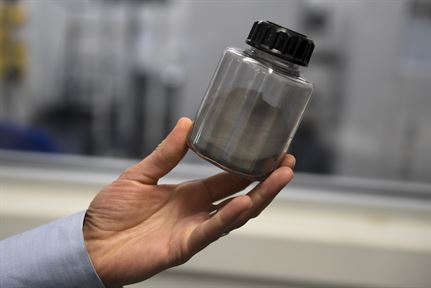Metal Powders: Types, Characteristics, and Applications
Metal powders are used in many manufacturing techniques in order to produce metal parts. Use of metal powders eliminates waste in comparison with traditional machining and is versatile in creating a variety of metal and alloy components. Metal powder technologies are at the forefront of the progressive era of a smarter and greener fabrication.
What are metal powders?
Metal powders are finely divided base materials for metal-part production. The particle size of most metal powders varies from 5-200 µm [1]. Some common fabrication techniques that utilise metal powders are powder metallurgy, additive manufacturing, surface coating, soft magnetic applications, and metal injection moulding. Most types of metals and their alloys come in metal powders such as iron, aluminium, bronze, chromium, cobalt, metal carbides, silicon, and more [2].
Characteristics of metal powders
The properties of the fabricated end product made from base metal powders are dependent on the characterisation of the powder from production. The main characteristics that describe metal powders are as follows:
- Morphology – describes the shape of the particle and its contour surface (Table 1)
- Granulometry – specifies particle size and size distribution
- Chemical composition – determines the level of element purity
- Surface area – measures the actual amount of surface area per unit mass and gas adsorption by the BET (Brunauer–Emmett–Taylor) method or the permeation technique
- Powder surface topography – shows the nature of the surface of individual particles (fineness, roughness, sharpness)
- Compressibility – indicates the measure to which a powder will compress or densify upon application of external pressure [3]
Table 1- Definition of particle shape
| Type | Description |
| Acicular | Needle shaped |
| Sharp | polyhedral shape or edged |
| Granular | Having approximately an equidimensional, irregular shape |
| Dendritic | Showing a branched crystalline shape |
| Fibrous | Regularly or irregularly thread-like |
| Flaky | Plate-like |
| Crystalline | Freely developed in a fluid medium: of geometric shape |
| Irregular | No symmetry |
| Modular | rounded but irregularly shaped |
| Spherical | Globe-like in shape |
Table 1: Definition of particle shape. Retrieved from Ref. 1.
The end-users benefit from consistent powder characteristics as the dies are filled easily and voids are avoided in between larger particles. In additive manufacturing, metal powders must be nominally spherical with a particle distribution to promote good packing density that will exhibit desirable mechanical properties [3].
Types of metal powders by manufacturing methods

Different metal powders require different ways of production due to their distinct physical and chemical characteristics. For decades, various manufacturing processes of metal powders have been devised, developed, and applied. Some of the most widely used methods are described below.
Machining & grinding
Milled metal powders are produced by having metals physically ground by a milling machine, resulting in irregularly shaped powders of any fine size. This process, however, is not applicable to combustible metals in powdered form [2].
Reduction
The crushed metal oxide can be reduced to a powdered form when it is mixed with a carbon source such as coke and heated to a temperature below the melting point in a continuous furnace or kiln. A pure iron with a sponge-like structure is collected when oxygen from the iron oxide reacts to the hydrogen atmosphere. It is then finally reground, ready for fabrication [4].
Atomisation
The atomisation process is different for metals with an either high or low melting point. For low melting point metals or alloys, it is first molten and kept in a tank. It is then suctioned into an atomizing nozzle. This process divides the molten metal into smaller droplets that eventually form into metal powder as it cools and solidifies. For metals and alloys with a higher melting point, the molten metal is streamed down into an orifice and a jet of atomised gas or fluid breaks the stream down into powdered particles. The characteristics of the metal powders can be modified by controlling some or a combination of process variables such as the temperature or stream velocity [5].
Electrolytic precipitation
Precipitated metal powders are produced through electrolysis or electrolytic deposition. It is a process that results in powders with high purity, high density, and precise particle size. For iron, two electrodes are connected to an electrical supply. A steel and stainless steel plate serve as an anode and cathode, respectively, as they are placed and dipped in an appropriate electrolyte. For 50 hours, deposits of pure electrolytic iron are collected from the cathodic plate [4].
Metal powder applications
Additive Manufacturing
Metal powders are widely used as a material for additive manufacturing. Selective laser melting (SLM) for example, is an enhanced powder metallurgy process that follows a computer-aided design (CAD) to direct a high-powered laser to melt and then fuse metallic powders together in a layer-by-layer manner to form a final part. This process is widely used in aerospace, automotive, and medical industries to make prototypes, lightweight components, and complex parts [6].
Alloying and Plating
Metal powders like bismuth, nickel, and manganese are used as an alloying additive to create stronger and corrosion-free steel. Cadmium oxide powders are used for lubricants and bearings, as well as in plating steel and glazing ceramics [7].
Sources
[1] W. Brian James (2015) ‘Powder Metallurgy Methods and Applications’. In P. Samal and J. Newkirk (Ed.s), ASM Handbook, vol. 7, ASM International
[2] (n.d.) Metal Powders (powdered metals) Information. Engineering 360. Retrieved from: https://www.globalspec.com/
[3] K.S. Narasimhan and M.O.H. Amuda (2017) Powder Characterization. Reference Module in Materials Science and Materials Engineering.
[4] (n.d.) Making Metal Powder. MPIF. Retrieved from: https://www.mpif.org/IntrotoPM/MakingMetalPowder.aspx
[5] R. Raja and M. Rajkumar (2015) A Short Note on Manufacturing Process of Metal Powders. IJRCAR. vol. 3. iss. 7. Pp. 120-8.
[6] (n.d.) Selective laser melting (SLM). CONCEPTLASER. Retrieved from: https://www.concept-laser.de/en/glossar/selective-laser-melting.html
[7] (2018) Common Uses for Powdered Meals. Belmont. Retrieved from: https://www.belmontmetals.com/common-uses-for-powdered-metals/